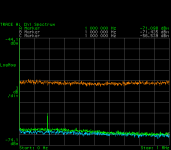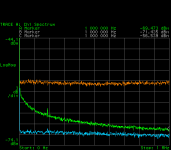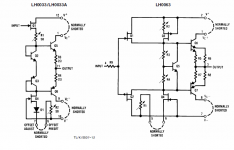Hmm, any link to that paper? We purchased one to use, and rented a few different types as well. We needed to measure nanometer level vibrations from .001 hz up to about 100 hz, and single digit nanometer resolution was not doable. It seems that the wavelengths for all the equipment we examined were just too long for that level of accuracy.Its been done. There was a study presented to the AES years ago by a UK capacitor manufacturer. They used something like a laser inferometer to detect the mechanical changes in dimension of a film cap under current.
Easy to measure with the sensitive equipment they had, but as I remember, the peak excursion was on the order of magnitude of the molecule size of the cap foil material.
Jan
jn
JN,
Sounds like you are talking electron microscope realm of resolution there! What is the shortest wavelength laser interferometry equipment out there? That would be tiny and probably right up someone there for someone from Fermi or someone looking for a quark or lepton to answer!
Sounds like you are talking electron microscope realm of resolution there! What is the shortest wavelength laser interferometry equipment out there? That would be tiny and probably right up someone there for someone from Fermi or someone looking for a quark or lepton to answer!
JN,
Sounds like you are talking electron microscope realm of resolution there! What is the shortest wavelength laser interferometry equipment out there? That would be tiny and probably right up someone there for someone from Fermi or someone looking for a quark or lepton to answer!
The next proposed accelerator is a pair of 15 mile long linears. The beams are on the order of 3 to 5 nanometers thick by 250 nanometers wide, and are very powerful. Since the idea is to aim them at each other, if one beam is 10 nanometers too high, it will miss the other. The magnets which focus the beam to that thickness can also transfer vibration to the beam.
So, we have to measure the magnet vibration, and use active cancellation to quiet it down. We already dropped from 4.5K helium to 1.8K superfluid so there was no viscosity to the fluid being used to cool the magnet.
jn
Since the 210c is about 200 usd how much for the non high temp plastic one ?There have been a couple of mentions of paralleling amplifiers for low noise test measurements. Before I forget this old idea still has merit. IC instrumentation amplifiers can be paralleled and their outputs combined with no extra components. The SSM2219, THAT1512 would both work here (unfortunately the outputs only add so so 4 parallel G =1000 amps would have G = 4000 but <.5nV noise). The best candidate is the new AD8229 which has 1nV RTI noise at a lower closed-loop gain. The 210C version of the AD8229 is for oil well exploration and has a price to match, there is now a plastic version.
You can also stack in two groups with inputs cross-coupled and get diff-in diff-out.
I tried ADA4898 several years ago and I have recently placed it in my last preamp - it is a very good part.
ADA4899 tested for audio as well - perfect part (yes 1/f corner is higher), +/-6V is a limitation. I guess it is so good (for audio) for the reason that because ot the high speed it has no problems with HF interferences.
P.S.: John might appreciate that ADA4899 OLG corner is at 20kHz = flat OLG at audio band.
Another AD part with good open loop bandwidth is the AD811, it's OLG is 21 KHz.
Since the 210c is about 200 usd how much for the non high temp plastic one ?
I was told $3-$5, sorry if that was not correct. Hard to believe the price I know, even harder to believe is that these instrument packages often burn up while logging data (down hole).
Picked up a tube in gold ceramic packages today, the benefits of the right friends.
Last edited:
Hmm, any link to that paper? We purchased one to use, and rented a few different types as well. We needed to measure nanometer level vibrations from .001 hz up to about 100 hz, and single digit nanometer resolution was not doable. It seems that the wavelengths for all the equipment we examined were just too long for that level of accuracy.
jn
I'll put you in touch with my guy that did this stuff on DARPA grants with femto-second laser pulses. If I told you what he said he could measure you would not believe me and he would have to kill me.
OTOH I have held a 9 digit digital caliper in my hand ~$2000.
OTOH I have held a 9 digit digital caliper in my hand ~$2000.
The calibration disc must really be a white gloves affair.
Thanks,
Chris
Nice for an MC I would guess. I like the trick of bringing the FB pin out in the input side to minimize Like and C to the feedback node
Amazing performance from modern opamps!
Amazing performance from modern opamps!
Yes, I'm using here 20 opamps in parallel ( 10 pairs ADA4898) for noise measurements.
Delivers 220 pV/sqrt Hz from a few Hz to 1MHz.
Blue line: input shorted,
brown line = noise of 60 Ohm = 1nV/sqrt Hz
green = noise of 4 Sanyo Eneloop NiMH AA in series
2nd pic is a 2/3AA Lithium Cell.
Probably the Eneloops are even better. It's time to update
my second preamp so that I can use the cross correlation
capability of the analyzer, that should bring 25 dB more.
I wanted to try NiCd, but I cannot buy them here any more.
Gerhard
Attachments
Last edited:
Traditionally I have used a SNA-33 spectrumanalyzer 20Hz to 26 GHz with 1 Hz resolution.
That one has a 50 Ohm input, could not be different and the preamp must be able to
drive 50 Ohms.
These pictures have been made with an Agilent 89441A whose inputs can be 50, 75
or 1 Meg, at least for the lowest 10 MHz. That can make it simpler.
AC coupling into 50 Ohm with a lower -3 dB corner of 0.1 Hz would require a huge
output capacitor, so I took a slightly different route. I chose 10k input impedance at
the input of the preamp, so that takes about 150 uF. With 10k, offset starts to hurt
at > +40 dB, at least for the parallel input stages. (from bias current)
Since I needed 80 dB, I have dc blocks at input, +40dB and +80 dB stages.
There is a follower after the +80 dB dc block to drive the 50 Ohm.
The follower can be boosted to +6 dB to make up for the loss of the
49R9 source termination when a 50 Ohm load is used.
So, while the output is driven directly by an opamp, one could argue that
it is AC coupled.
BTW I had nice WIMA foil caps for the input, but only 3 of them, 10u each.
I did the board layout for them but could not get more. Those that I could
get do not fit. I'll have to live with 1 Hz lower corner until next layout. :-(
That one has a 50 Ohm input, could not be different and the preamp must be able to
drive 50 Ohms.
These pictures have been made with an Agilent 89441A whose inputs can be 50, 75
or 1 Meg, at least for the lowest 10 MHz. That can make it simpler.
AC coupling into 50 Ohm with a lower -3 dB corner of 0.1 Hz would require a huge
output capacitor, so I took a slightly different route. I chose 10k input impedance at
the input of the preamp, so that takes about 150 uF. With 10k, offset starts to hurt
at > +40 dB, at least for the parallel input stages. (from bias current)
Since I needed 80 dB, I have dc blocks at input, +40dB and +80 dB stages.
There is a follower after the +80 dB dc block to drive the 50 Ohm.
The follower can be boosted to +6 dB to make up for the loss of the
49R9 source termination when a 50 Ohm load is used.
So, while the output is driven directly by an opamp, one could argue that
it is AC coupled.
BTW I had nice WIMA foil caps for the input, but only 3 of them, 10u each.
I did the board layout for them but could not get more. Those that I could
get do not fit. I'll have to live with 1 Hz lower corner until next layout. :-(
Last edited:
Hmm, any link to that paper? We purchased one to use, and rented a few different types as well. We needed to measure nanometer level vibrations from .001 hz up to about 100 hz, and single digit nanometer resolution was not doable. It seems that the wavelengths for all the equipment we examined were just too long for that level of accuracy.
jn
It's at least 5 years ago, I think the company was RTC (?). I'd have to look.
Jan
Another AD part with good open loop bandwidth is the AD811, it's OLG is 21 KHz.
Or the AD815. Also drives 50 ohms at 400mA. A great headphone or small speaker amp.
Guys, do you remember these JFET input buffers?
Ugly. We had them in our ultrasonics phased arrays. Very different rise and fall
times & overshoot IIRC. They were history when Comlinear published their CLC.....
Maybe I still have a few in my junk box. I heard their prices are astronomical now.
Last edited:
Well you have more than the stocking Dist. in the USA . Could be an interesting MC headamp. Say low gain of 10 to 20 ?I was told $3-$5, sorry if that was not correct. Hard to believe the price I know, even harder to believe is that these instrument packages often burn up while logging data (down hole).
Picked up a tube in gold ceramic packages today, the benefits of the right friends.
- Status
- Not open for further replies.
- Home
- Member Areas
- The Lounge
- John Curl's Blowtorch preamplifier part II


